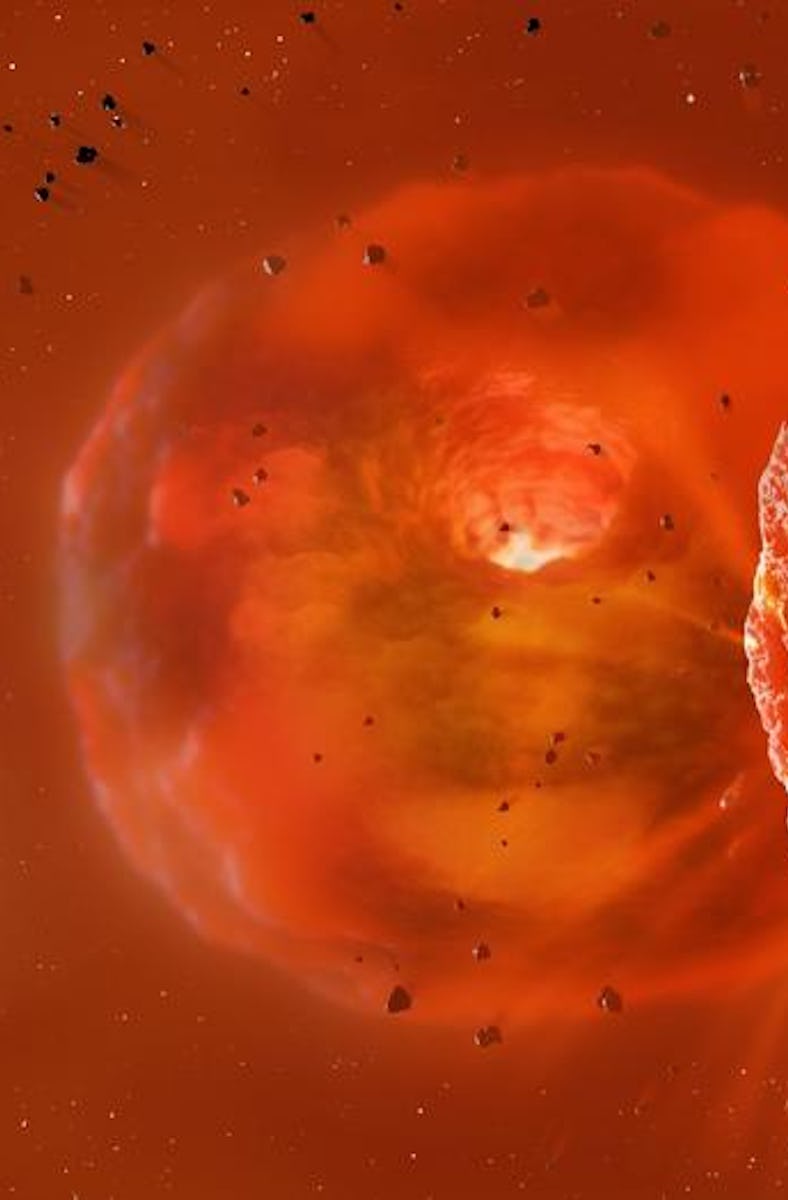Scientists Spot Massive Planetesimal Collision That Eclipsed Its Host Star for 500 Days
How an accidental discovery uncovered a cataclysmic smash-up some 1,800 light years away.

The universe is often portrayed as a vast stretch of emptiness, but in reality, it’s filled with unfathomable explosions, mind-bending gravitational anomalies, and an untold number of cataclysmic collisions. Case in point: A team of astrophysicists at the Netherlands’ Leiden Observatory recently stumbled upon a particularly gigantic smash-up — one so big that when a giant, icy, would-be planet careened into another planetary neighbor, it produced enough haze to eclipse its parent star for 500 days.
Astronomer Matthew Kenworthy, an associate professor of astronomy at the Leiden Observatory, stumbled across this stunning impact while searching for stellar rings and newly formed exoplanets. Glimpsing the star ASASSN-21qj some 1,800 light years away, Kenworthy noticed that it was reminiscent of another star that dimmed during the transit of a planet filled with a disk of potentially moon-forming material. But in sharp contrast with its stellar predecessor, this cloud was big and slow, and that’s when Kenworthy started investigating further.
In a paper published Wednesday in the journal Nature, Kenworthy and his team describe the new star, named after the ground-based telescope collaboration that discovered it — the All-Sky Automated Survey for Supernovae — and how their accidental discovery uncovered an awe-inspiring space collision.
A “highly, highly unlikely” coincidence
Not exactly sure what they were seeing, Kenworthy published a query on X, formerly known as Twitter, and learned that data from NASA’s NEOWISE mission showed this star had brightened in the infrared for several hundred days about three years earlier. As Kenworthy tells Inverse, that was too weird to be a coincidence and was his first clue that he was looking at something extraordinary.
“Two separate events, which are just completely unrelated and happen close by in time astronomically speaking, is highly, highly unlikely. We’re probably looking at the same thing, one event is causing these two separate effects,” Kenworthy tells Inverse.
The team ruled out the idea of another star because to create that degree of glow, the star would have to be big enough to be detected before now. After running a simulation and piecing together their observations, they arrived at the conclusion that the infrared data was revealing a hot event, and the optical data was actually a shadow of its aftermath.
Sample of computer simulations that calculated the immense heat and water vapor as two icy planetesimals collided around the star ASASSN-21qj 1,800 light years away.
The story of a crash
As the data coalesced, Kenworthy and his team slowly developed the cosmic story of what happened in orbit around ASASSN-21qj. About 16 to 20 astronomical units (AU) from the star — roughly the distance that Uranus orbits the Sun — an icy giant planetesimal crashed with another hefty object. At least one of them was filled with ice, which cooled the region down to the 1,000 Kelvin (1,340 degrees Fahrenheit) temperature that scientists observed. Usually, the temperature of a pulverized rocky planet would have been significantly hotter, Kenworthy says.
The crash created “a large luminous” rocky vapor cloud that is “glowing furiously like a barbecue coal,” Kenworthy says. When it shortly thereafter passed in front of the star, it blocked its light for roughly 500 days.
To get a better picture of this colossal collision, the team’s research will benefit from follow-up observations with infrared instruments, such as the Mid-Infrared Instrument (MIRI) onboard the James Webb Space Telescope. Additionally, when the cloud moves to the other side of the star in about five or ten years, starlight might bounce off the cloud and help verify Kenworthy’s explosive conclusions.
For now, ASASSN-21qj is just another exciting example of the ephemeral, ever-changing (and definitely not empty) nature of the universe.
This article was originally published on